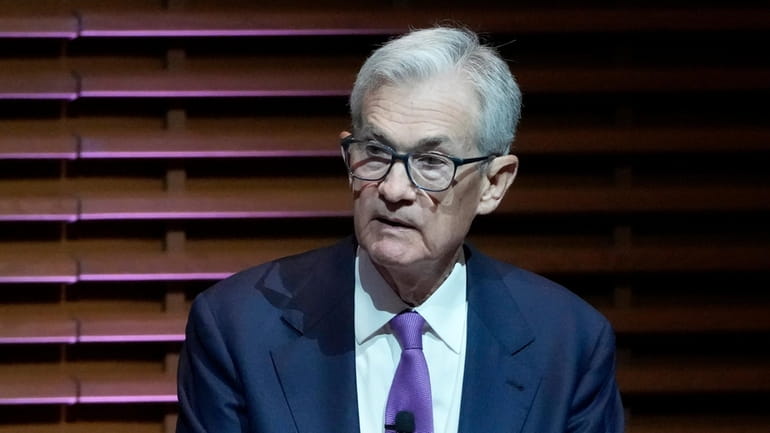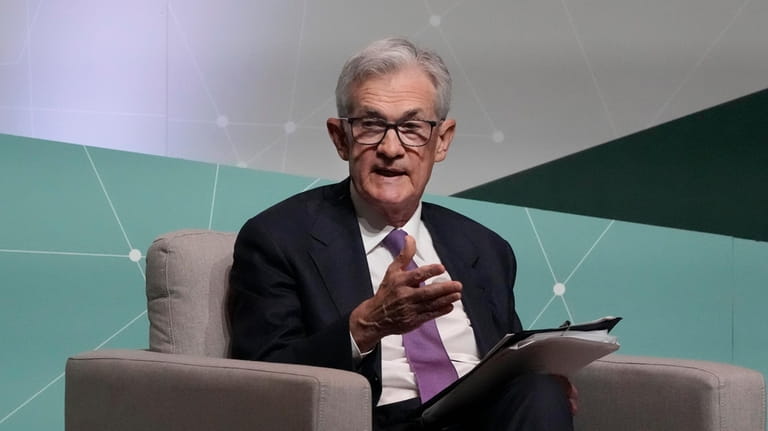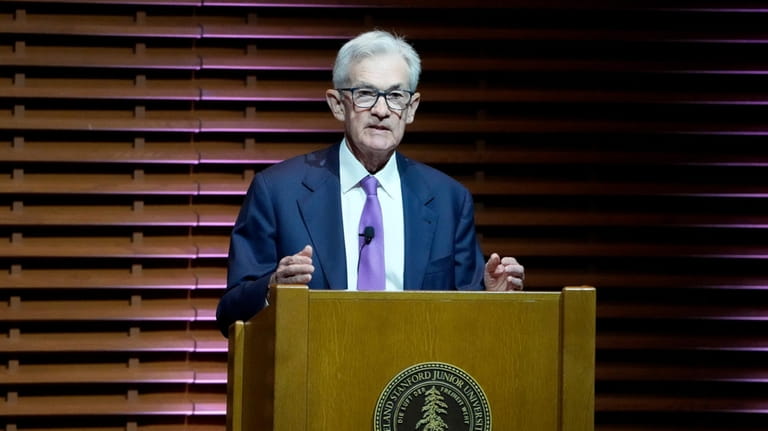Powell: Fed still sees rate cuts this year; election timing won't affect decision

Federal Reserve Board Chair Jerome Powell speaks at the Business, Government and Society Forum at Stanford University in Stanford, Calif., Wednesday, April 3, 2024. Credit: AP/Jeff Chiu
WASHINGTON — Federal Reserve officials will likely reduce their benchmark interest rate later this year, Chair Jerome Powell said Wednesday, despite recent reports showing that the U.S. economy is still strong and that U.S. inflation picked up in January and February.
“The recent data do not ... materially change the overall picture,” Powell said in a speech at Stanford University, “which continues to be one of solid growth, a strong but rebalancing labor market, and inflation moving down toward 2% on a sometimes bumpy path.”
Most Fed officials “see it as likely to be appropriate” to start cutting their key rate “at some point this year," he added.
In his speech, Powell also sought to dispel any notion that the Fed’s interest-rate decisions might be affected by this year’s presidential election campaign. The Fed will meet and decide whether to cut rates during the peak of the campaign, in July and September.
Fed officials will face a delicate decision during those months and during their upcoming meetings in May and June. The policymakers must take care not to cut rates too soon or inflation could stay high — or even re-accelerate. Annual inflation ticked up in February to 2.5%, according to the central bank’s preferred measure, though that was down sharply from its peak of 7.1%.
Yet if Fed officials wait too long to reduce rates, the current high borrowing costs for mortgages, car loans and business loans could seriously weaken the economy — even tip it into a recession.
Though inflation has cooled significantly from its peak, it remains above the Fed's 2% target. And average prices are still well above their pre-pandemic levels — a source of discontent for many Americans and potentially a threat to President Joe Biden's re-election bid.

Federal Reserve Board Chair Jerome Powell speaks at the Business, Government and Society Forum at Stanford University in Stanford, Calif., Wednesday, April 3, 2024. Credit: AP/Jeff Chiu
The recent pickup in inflation, though slight, has led some economists to postpone their projections for when the Fed will begin cutting rates. Rate cuts would begin to reverse the 11 increases the Fed carried out beginning in March 2022 to fight the worst inflation bout in four decades. A lower Fed rate would likely lead, over time, to reduced borrowing rates for households and businesses.
Some economists now predict that the central bank’s first rate cut won’t come until July or even later. That expectation has fueled speculation on Wall Street that the Fed might end up deciding to delay rate cuts until after the presidential election. The Fed’s November meeting will take place Nov. 6-7, immediately after Election Day.
Former President Donald Trump has called Powell “political” for considering rate cuts that Trump has said could benefit Biden and other Democrats. Powell was first nominated to be Fed chair by Trump, who has said that, if he is elected president, he will replace Powell when the chair’s term ends in 2026.
In his speech Wednesday, Powell noted that Congress intended the Fed to be fully independent of politics, with officials serving long terms that don’t coincide with elections.

Federal Reserve Board Chair Jerome Powell speaks at the Business, Government and Society Forum at Stanford University in Stanford, Calif., Wednesday, April 3, 2024. Credit: AP/Jeff Chiu
“This independence,” Powell said, “both enables and requires us to make our monetary policy decisions without consideration of short-term political matters.”
In the past, presidents such as Lyndon Johnson and Richard Nixon sometimes bluntly pressured Fed leaders to cut rates before elections to try to boost the economy. In contrast, recent presidents have avoided publicly pressuring the Fed, with the striking exception of Trump, who denounced Powell for raising the Fed's benchmark rate in 2018 during the Trump presidency.
“If you look at the modern historical record, you’ll see that the Fed has been prepared to move or not move, and do what it thinks is the right thing for the economy ... without regard to outside considerations,” Powell said, “and it’s important to just have people know that.”
When they met two weeks ago, Fed officials forecast that they could cut their benchmark rate three times this year. Still, nearly half the 19 policymakers penciled in just two or fewer rate cuts.
Strong economic growth could diminish the likelihood of a Fed rate cut later this year for two reasons. One is that steady hiring and brisk consumer spending can lead companies to raise prices and thereby worsen inflation.
The other reason is that a healthy economy reduces the need for the Fed to cut rates, which tends to stimulate growth. Typically, the central bank reduces its key rate when growth stumbles and companies start cutting jobs. Powell and other officials have underscored that as long as the economy remains healthy, they can take time to assess the path of inflation and ensure that it's headed back down to their 2% target.
Last week, a government report showed that consumer spending accelerated in February, and prices rose faster than is consisted with the Fed’s inflation target for the second straight month.
“On inflation, it is too soon to say whether the recent readings represent more than just a bump,” Powell said. “Given the strength of the economy and progress on inflation so far, we have time to let the incoming data guide our decisions on policy.”
In remarks this week, some other Fed officials reiterated their expectations for three quarter-point rate reductions this year, while also underscoring that such cuts would depend on inflation slowing from the January and February readings.
“I think three is still reasonable, but it’s a close call,” Loretta Mester, president of the Federal Reserve’s Cleveland branch, told reporters Tuesday.
Still, Raphael Bostic, president of the Atlanta Fed, said earlier Wednesday on CNBC that he envisions just one interest rate cut this year, likely in the final three months of the year.
Mester and Bostic are among the 12 policymakers with a vote on the central bank’s interest rate decisions this year.
Details on the charges in body-parts case ... LIRR discounts in NYC ... BOCES does Billy Joel ... Hottest day of the year
Details on the charges in body-parts case ... LIRR discounts in NYC ... BOCES does Billy Joel ... Hottest day of the year
